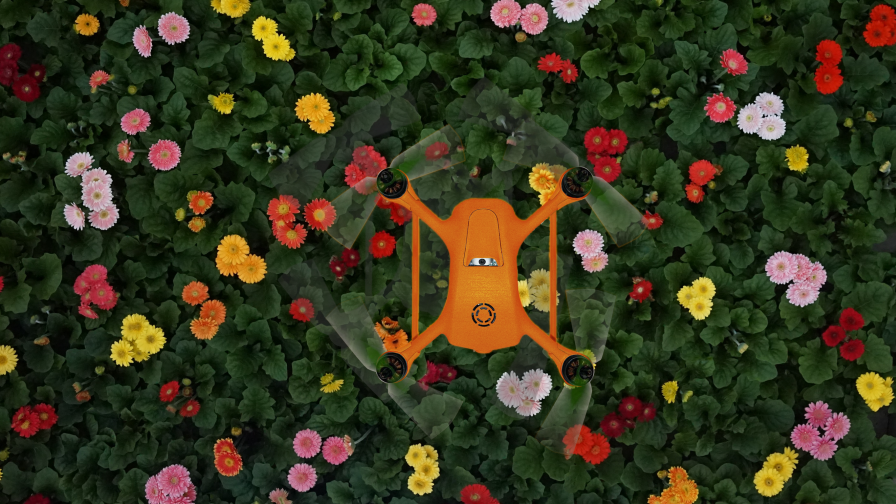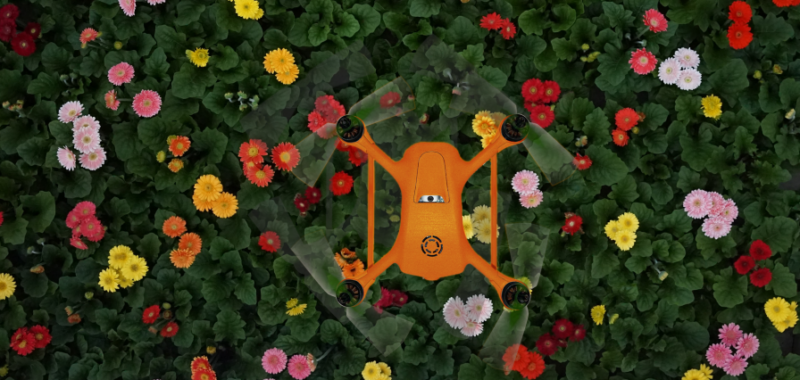
Drone over flower field | Corvus Robotics
Drones have been an increasing feature and supplementary labor force in the fields of agriculture, floriculture, and horticulture as a whole. The focus on the applications of drones in these spaces has been on their many transferrable capabilities related to production practices, including:
- Data collection
- Lightweight deliveries
- Soil analysis
- Stress monitoring
- Pest and disease scouting
- Pesticide application
- And more!
However, another area to be explored for crop cultivation is the phenomenon of drones and other robots taking over the role of pollinators, primarily from bees. Due to concerns about dwindling bee populations, the assistance and replacement of this vital task through drones has tremendous implications for growers around the world. Pollination drones are a new tool to improve crop production and protection, from cut flowers to produce and everything in between.
Pollination Problems Addressed through Drones
Australian and U.S. farmers are currently carrying out drone tests to see how they can be useful to a variety of different harvests. For example, Perfection Fresh, in South Australia, uses drones to aid in glasshouse pollination. In such a controlled setting that makes it harder to rely on natural pollinators, drones provide a quick and reliable substitution to the problem.
As an added bonus, the turbulence produced by drone rotors creates vibrations in nearby plants, creating more effective pollen distribution.
The Pros and Cons of Drones as Bee Replacements
In Kenya, honeybees are often used as “living fences,” shielding crops and harvests from roaming wildlife, including elephants.
“Drones cannot perform all the duties that the bees are doing in the environment, they can’t compete to that level,” says Newton Simiyu, a Project Manager at the Born Free Foundation, as reported by Context News.
However, other areas of the world, particularly those without many natural pollinators, find great benefit in the additional help that technological pollinators can bring.
Katja Hogendoorn, who researches native bees and pollination at the University of Adelaide in Australia, a place that isn’t home to native bumblebee populations, says “We can do a lot with technology, and drones are a viable option for pollination. We can’t solve for every risk with technology, but if drones can be used for mitigating risk in pollination, why not.”
Therefore, while it’s unlikely that drones will fully replace bees, they definitely have their place and use in modern farming and cultivation methods, not to mention their additional uses to horticulture outlined above.
Companies Funding Drone Development in Crop Production
Polybee is a Singapore-based software company that has partnered with the U.K. Agri-Tech Centre for the ‘Precision Pollination for Higher Strawberry Productivity and Quality’ initiative to increase pollination in controlled environment agriculture (CEA) settings using drones.
Stateside there is Dropcopter, a California company, whose product is used to dispense pollen in orchards.
Additionally, Harvard University has the ‘NSF Expeditions Robobee Project,’ which aims to create tiny robots that accurately mimic the actions of organic bees.
“To be effective, the technology needs to be “robust and scalable, and easy enough for farm workers to use with minimal training”, says Siddharth Jadhav, the founder and CEO of Polybee.
However, beyond the effectiveness of the technology, the other major concern is its affordability, and therefore accessibility, for the future of such products.
“The technology is not accessible to all, just to large companies and investors. Therein lies a threat,” says Hogendoorn.
0
1
5
How Pollination Drones Are Emerging as Alternatives to Bees

